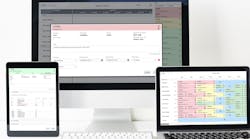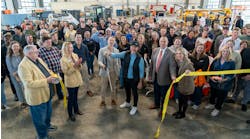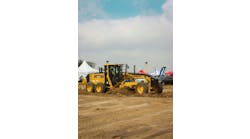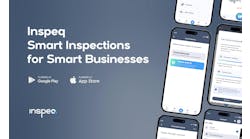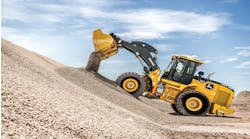Robert Gray, vice president of sales & marketing, Wynne Systems, talks about the company’s new features such as MobileLink, ReadyLink and its new acquisition, Dispatching Solutions; enhancements to its customer portal; the growing ability of customers to manage transactions and communications online; dashboards, reports and more.
RER: What are the new developments in your software during the past year?
Gray: We have been consistently adding new features to our mobile application, MobileLink, that delivers real business value. This includes our new transfer feature, which manages both incoming and outgoing equipment: utilization is no longer compromised by equipment waiting in the yard for paperwork and potentially being overlooked. Other features like suggesting which unit to put on rent based on longest time since last rental allows companies to wear their fleet more evenly. This lowers maintenance costs on specific units that tend to be put out on rent even if others in the same category and class are available.
We’ve also released ReadyLink, our service prioritization web application. Service managers have total control and visibility to their department’s workload, surfacing high priority maintenance or service tasks to maximize utilization and profitability of their equipment. Companies who prepare their servicing needs in advance for reservations or highly utilized items are able to deliver on time and reduce costly and time-consuming exchanges and credits.
And finally, with our acquisition of Dispatching Solutions Inc. in 2018, we’ve been able to add transportation and logistics management to our product offerings, so that we’re able to address nearly every facet of the rental equipment process.
What new capabilities and functions have you added in regard to e-commerce?
RenterLink is our e-commerce platform that connects your business with your consumer. But it alone doesn’t address customers’ mindsets shifting from valuing customer experience over price and product when selecting vendors. Which is a good thing for our industry as a whole, as our offerings are less commoditized, but it places a heavy burden on companies to deliver an outstanding customer experience across all channels.
To address that we’ve enhanced our Customer Portal to be customizable so that our customers can market directly to their accounts. If there is a big storm approaching, you could display a targeted ad in Customer Portal for your generators and trash pumps and link them directly to RenterLink to display just those items. It’s a simple, yet effective, way to enhance that client/vendor relationship and take advantage of your e-commerce platform.
Can you give an example of how integration between telematics and your software have benefited your rental customers?
Yes, the ability to communicate and transact online is growing exponentially. Part of a customer’s experience is having the choice on how they interact with your business, and an online option is no longer a value-add, it’s an expectation. RenterLink gives them that flexibility by allowing them to manage transactions and communications on their terms. Reserve, request service or pickup, pay invoices — it’s a “hands-off” channel, yet provides that much more value to your customers.
To your knowledge are online reservations and communication of a piece of equipment being called off-rent increasing among your rental customers? How is your software making it easier?
Yes, the ability to communicate and transact online is growing exponentially. Part of a customer’s experience is having the choice on how they interact with your business, and an online option is no longer a value-add, it’s an expectation. RenterLink gives them that flexibility by allowing them to manage transactions and communications on their terms. Reserve, request service or pickup, pay invoices — it’s a “hands-off” channel, yet provides that much more value to your customers.
What kind of support do you offer rental companies that use your software, i.e., call-in helpdesks, online chats, instruction for users, etc.?
Our clients have access to an online service desk, where they can view and manage their tickets and communicate with our service team. In addition, we have staffed our service desk so that we can offer 24 by 7 support—which is critical for our clients.
Above all else, we have customer success managers who, as the name would imply, are dedicated to managing their clients’ success. This means having a deep understanding of business objectives, initiatives and short and long-term goals of their clients. By knowing this, CSMs can provide strategic plans that marry our software solutions to clients’ goals and initiatives.
In the day-to-day operation of a rental business communication is essential between the shop, sales staff, yard people, counter people and delivery drivers. How does this communication function in real time in terms of determining the immediate location and status of an asset?
Immediacy, accuracy and accessibility are critical for rental businesses to communicate and operate effectively. Half the battle is that the data is real-time, no matter if it’s from their core rental solution or from a third-party GPS or telematic system. Yesterday’s news, while interesting and relevant, is still old news.
But to get to real-time data, it requires inputting data when events occur. If a flood of equipment returns at the end of the day, you can be certain something is going to get overlooked. And we all know, it only takes one missing piece of info to disrupt the workload of multiple people across several departments, even branches. That’s why mobile apps tailored towards streamlining operational tasks are necessary; it removes opportunities for oversight, speeds up the process as a whole, and continues the effective communication that companies work so hard to achieve.
What kind of dashboards does your software have and what information do they offer?
Our reporting and dashboard functionality enable users to create their own reports and dashboards. This is necessary for companies who require large, cross-functional reporting. Users, or business intelligence analysts, can build dashboards quickly to address the different goals for different departments. Let’s say your logistics center and your key managers want the same data, such as a listing of deliveries and pick-ups. The logistics center will benefit more from an operational dashboard that auto-refreshes every few minutes so they can quickly assess what’s due next. At the same time, your key managers would find more use from seeing the same data in an analytic dashboard, so they can reflect on results rather than actions. It’s the needs that will dictate the most effective format for dashboards, so having the capability to create and edit dashboards as needed is hugely imperative for effective rental companies.
What information can your customers access through your online portal, and how “user-friendly” is it?
Wynne’s Customer Portal is a great one-stop resource for your customers. They have access to create a reservation, view current rentals and request a pickup or extend the rental, view invoices and pay them online, as well as a huge selection of reporting options. It’s really simple to use, and the interface allows you to customize their home page however you wish. Display dashboards, ads, their branch contact information—it’s designed to provide any information that your customer could ever possibly need.
What would you say are the reports your customers use the most, that they find most beneficial?
From our perspective, these are two different types of reports. Reports that are used most often are ones that deliver actionable data, like a due for service or an outstanding A/R report. These are the type of reports that are run daily or weekly that help a person, or a group of people, be more effective at their job. While the person who uses that report may find it beneficial, it doesn’t necessarily add value to the company as a whole.
Reports that are the most beneficial are ones that drive initiatives forward. For example, if a company wanted to reduce the amount of idle time for their drivers, they would want a report that shows how long drivers are waiting at a job site or branch. Now, they’ve decided to reduce that time by 30 percent within the first six months and have implemented new processes to support that. Their driver idle time report would be run daily to provide insight as to how well their initiative is progressing. To another company, this information could be meaningless. But for the company who’s looking to reduce their fuel costs and increase trips per driver per day, this is huge. Ultimately, the value of the report depends on what the company is trying to achieve.
Are there any particular software features you are working on that you are planning [that you are comfortable talking about]?
We consistently are working on enhancements to our ERP solution, but adding even more to our mobile and service applications. For MobileLink, we’re adding more features to make the counter less reliant on a workstation, like creating new customer job sites and creating sales orders.
In the ReadyLink app, we’re adding features that allow service managers to estimate work more accurately and several enhancements to improve fleet utilization across regions.
